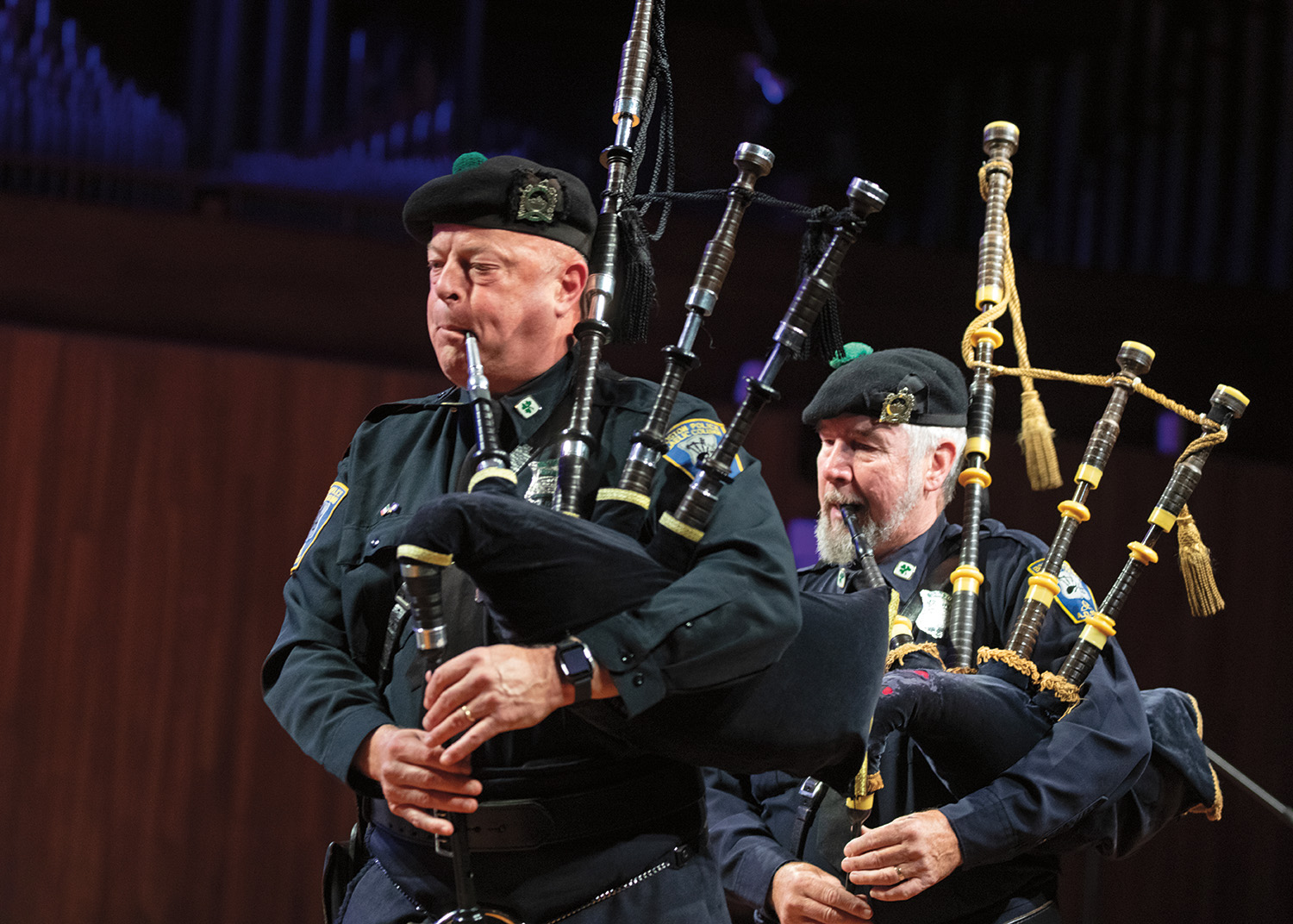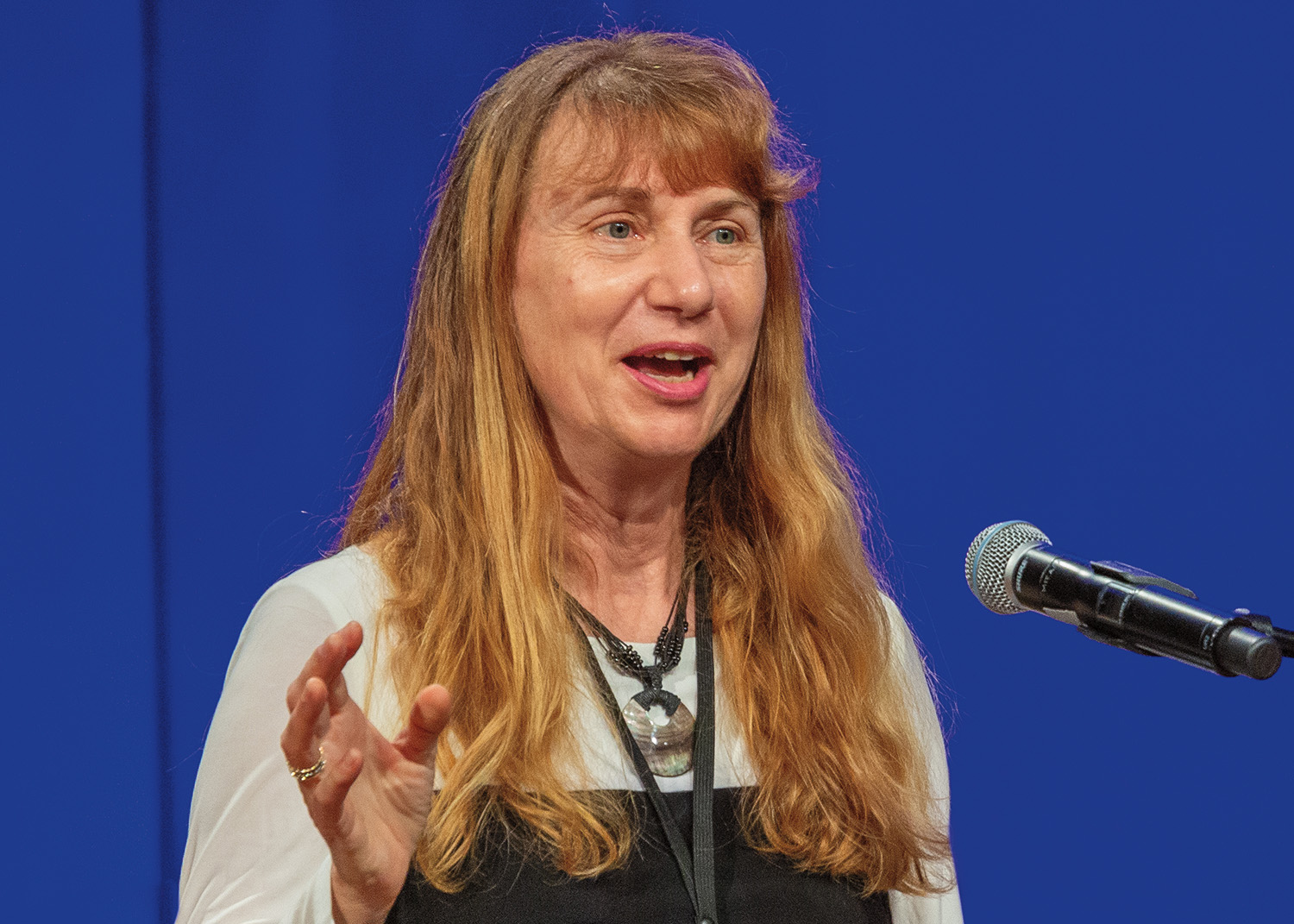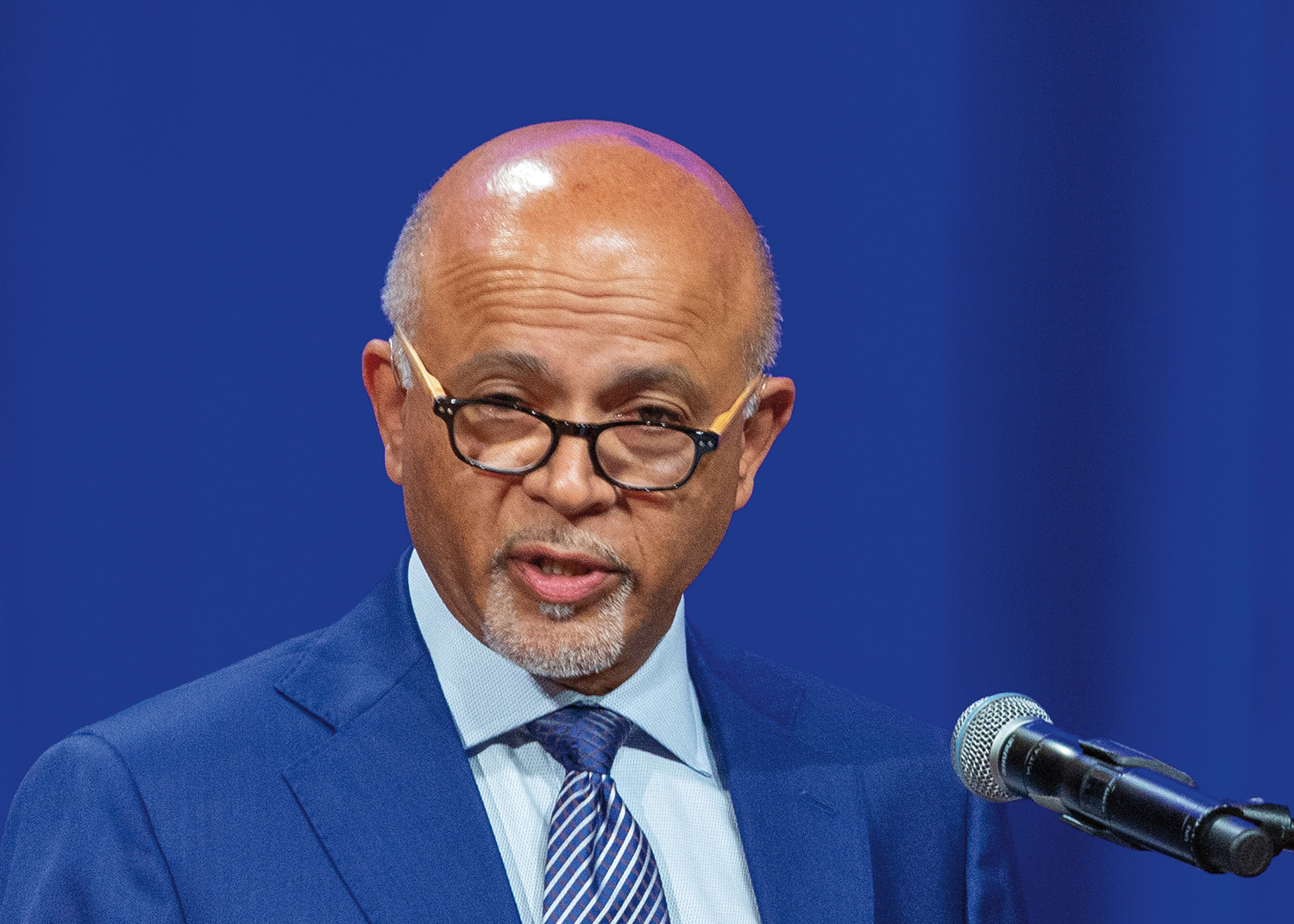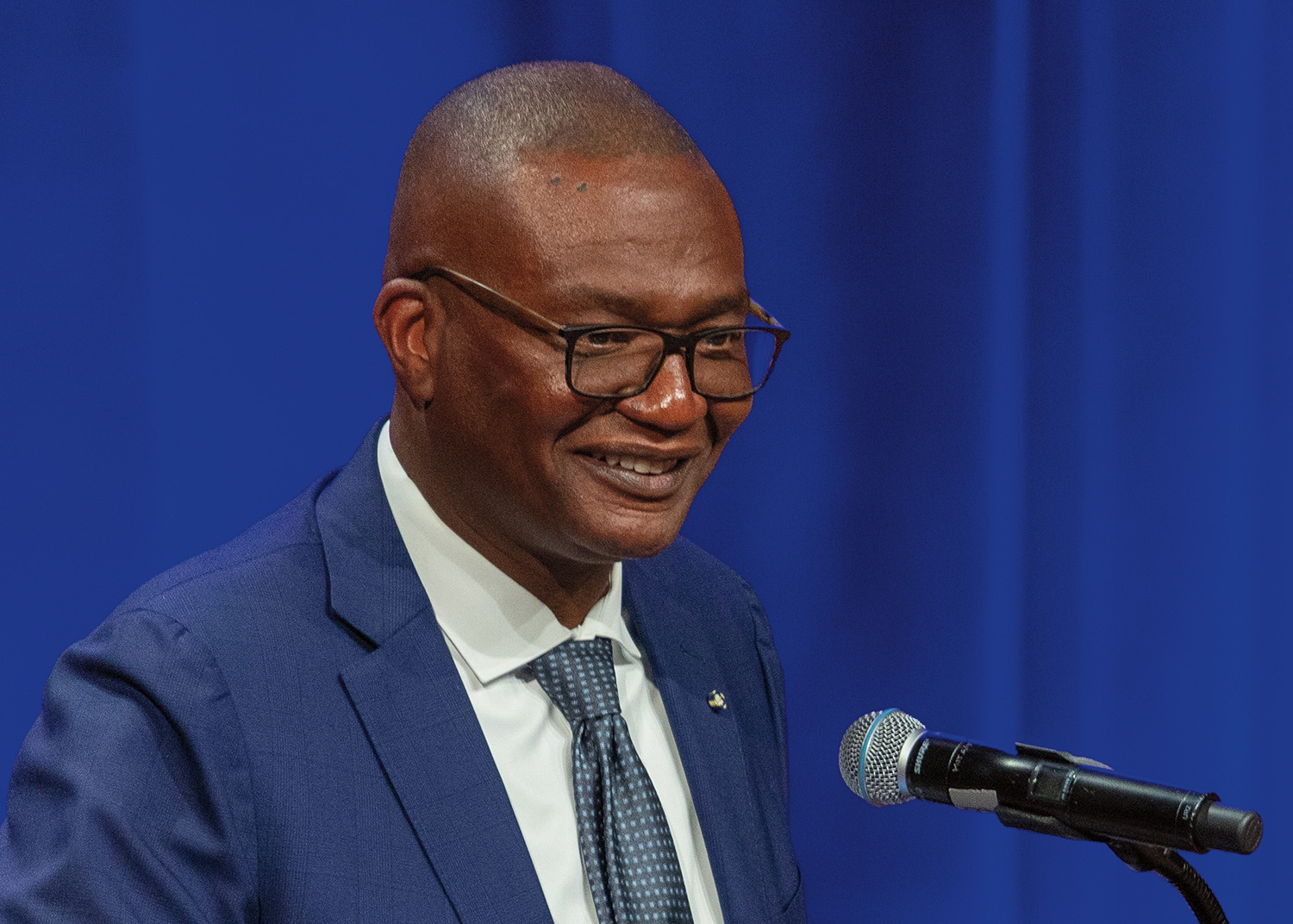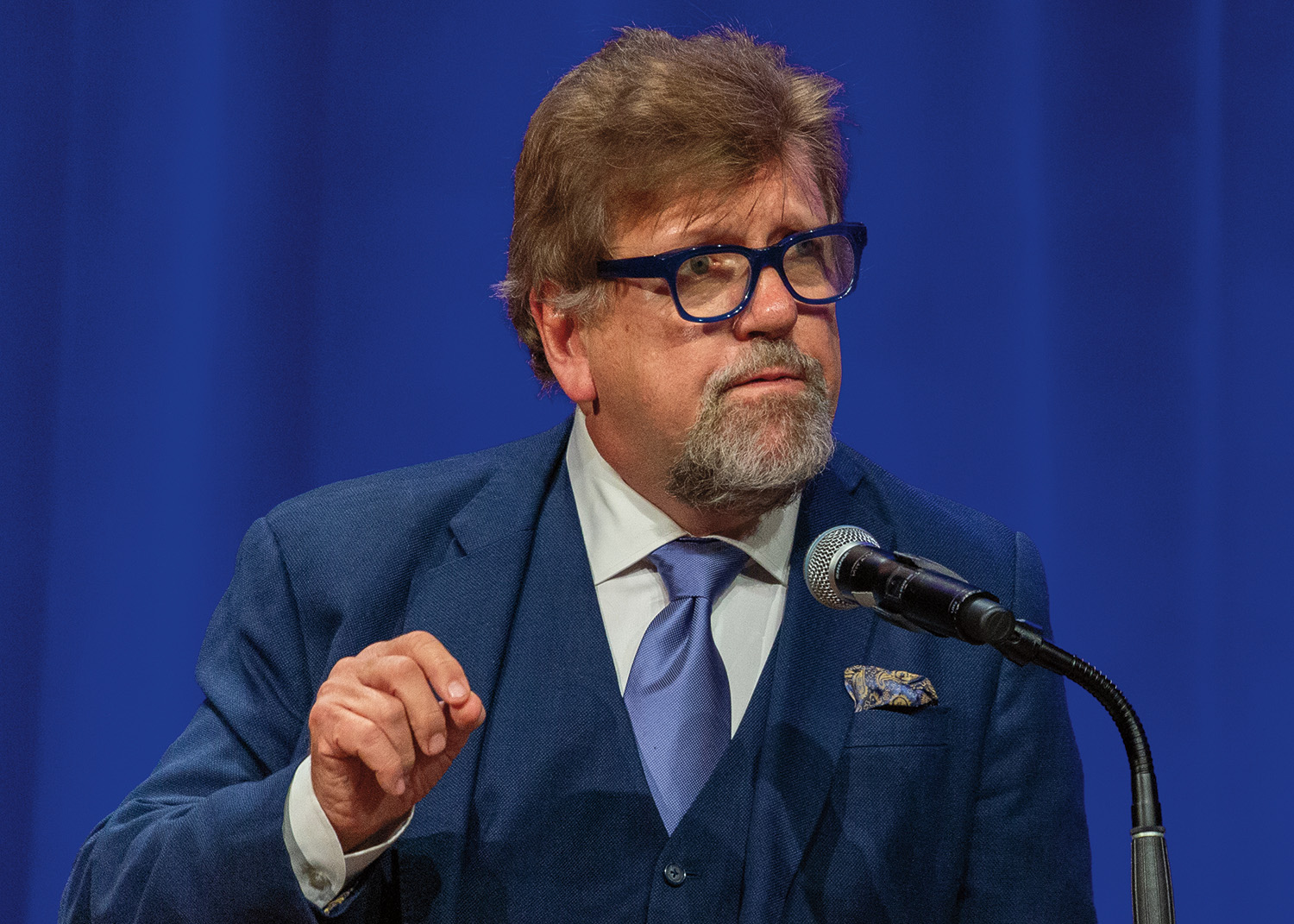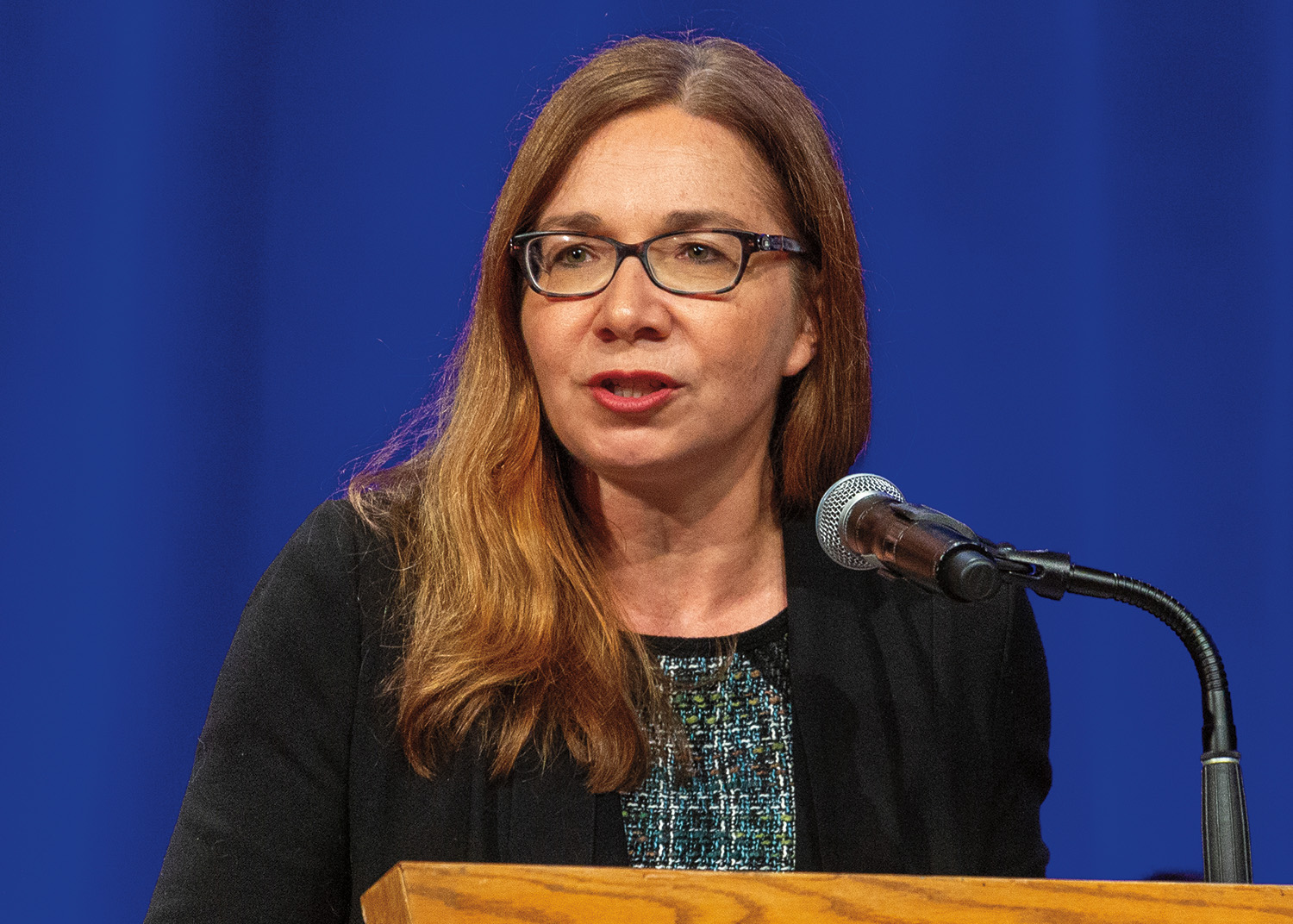2116th Stated Meeting | September 30, 2023 | Kresge Auditorium, Massachusetts Institute of Technology
On September 30, 2023, the Academy inducted members elected in 2022 and 2023. The class speakers at the Induction Ceremony addressed major issues facing the world today. The ceremony featured presentations from computer scientist Maja Matarić, author and physician Abraham Verghese, economist Kerwin Charles, artistic director Oskar Eustis, and atmospheric scientist Katharine Hayhoe. An edited version of their presentations follows.
Maja Matarić
Maja Matarić is the Chan Soon-Shiong Chair and Distinguished Professor of Computer Science at the University of Southern California Viterbi School of Engineering (with appointments in Neuroscience and Pediatrics) and Principal Scientist at Google DeepMind. She is also founding director of the USC Robotics and Autonomous Systems Center, codirector of the USC Robotics Research Lab, and past interim USC Vice President of Research, Vice Dean for Research, and President of the USC faculty and the Academic Senate. She was elected to the American Academy of Arts and Sciences in 2023.
What an incredible honor to be a member of this group and to be part of this event. This really is the best academy because it brings together an unparalleled diversity of minds and endeavors. (It’s not a competition, but we win!)
It is a unique privilege to address you. I will try to engage you on a topic that truly brings us all together, for no lesser stakes than the future of humanity. I am talking about AI, artificial intelligence, my area of expertise and responsibility. And as I will try to quickly convince you, it is everyone’s responsibility as well.
I have been a researcher in robotics and AI for thirty-six years. It has been an incredible journey, full of wonderful colleagues (also some arrogant jerks, but that’s humanity) and even more wonderful students. We have worked on endowing machines with the ability to help people who need help, and that has been remarkably satisfying, at least when it works. And it has worked. We have been able to measurably help stroke patients, elderly individuals with dementia, children on the autism spectrum, and more recently students experiencing anxiety and depression.
I didn’t self-identify as an AI researcher until recently, but AI’s umbrella is larger (and louder) now, and there is no end to the worthwhile challenges we can work on to improve the human condition through AI.
However, the latest breakthroughs in AI and its current and future uses have raised very serious concerns in recent months. First, a bit of historical context. AI was officially “born” in the mid-1950s. When I was an undergraduate in the late 1980s, there was a single AI class at the University of Kansas. It was taught at 8 am, so of course I did not take it! Today, AI courses are the most popular on campus; Stanford’s intro AI class, for example, is capped at 850 students each quarter. That gives you a sense of the scale of interest and investment.
Does it seem like AI just blew up all of a sudden? Well, it did. AI was advancing at a regular pace of research until just a handful of years ago, and then a confluence of circumstances propelled it to where it is today. And it has continued to accelerate. Those circumstances were: 1) an abundance of data (via the web, social media, videos, images, books, music . . . all of human creation available in digital form); 2) special processors created for computer games; and 3) some clever algorithms.
It took humanity less than a single lifetime to advance AI from playing tic-tac-toe and reading zip codes on letters, to driving autonomously, acing the MCATs and bar exams, decoding human thought via fMRI, recognizing any human who has been photographed, and creating visual art, music, poetry, plays, and novels.
AI can create derivative mash-ups (Mona Lisa with a pug face, Sinatra rapping, each of you singing parts from Hamilton, and so on), but it can also create worthy originals. And AI can be a creative collaborator, aiding our discovery in the sciences and humanities. It has, after all, been trained on all of human creation, so it is arguably the best student of all time. And it is already having an influence on every single human endeavor represented in this room.
But like human intelligence, on whose products it was trained, AI has a dark side. It has already tricked people into believing it is human and has hired them to do work for it. It has tried to destroy a marriage. It can break into computer security systems. And, most concerningly, it is getting better at creating recipes for bioweapons. It does all this in response to human questions and requests.
Consequently, experts are concerned that humanity has become vulnerable to AI in multiple ways. One concern is about “runaway AI”: if we are to AI as animals are to us, then it is not looking good for humanity as AI rapidly outpaces us.
Another concern is about “AI in bad hands.” By making AI accessible to all, society risks bad actors causing possibly irreversible large-scale destruction.
The third concern is the societal disruption created by “AI in the market economy.” AI tools are already paving the way to replace numerous jobs, with potentially massive economic implications. The surprise, besides the speed of change, is that most of those jobs are knowledge and creative work, not physical work that was historically eliminated by industrialization. Robotics is still a bit behind current AI, but it is coming, and it will address physical work.
What will this Academy’s inductions look like in an age when AI creates affordable and lucrative art, music, stories, novels, computer programs, contracts, policies, therapeutics, and just about everything else? How much better will our creations be? What will we be doing?
We humans have outdone ourselves by creating something that we already do not understand nor can we predict—which is apt since it is based on us. We do not understand ourselves nor can we predict our impact on the world.
AI is a wunderkind with tremendous potential that can become a monster if mistreated and abused. Will we nurture and contain it? Will we have the strength to say “no” even when it is easier to say “yes”? Bringing up this wunderkind is everyone’s job. Because it is, literally, about everyone’s job.
This is not the first or only fast-accelerating existential dilemma we have brought on ourselves. As in the other case, it is going to take all of us actively setting denial aside, caring, thinking beyond our comfortable areas of expertise, and working together on our collective future.
I am optimistic, because as this gathering reflects, we are astonishingly creative, wise, and caring, when we want to be.
And so, I’m happy we are in this together, and honored to be sharing this interesting time in history and this wonderful experience and celebration with all of you. Thank you and congratulations!
© 2024 by Maja Matarić
Abraham Verghese
Abraham Verghese is the Linda R. Meier and Joan F. Lane Provostial Professor of Medicine and Vice Chair for the Theory and Practice of Medicine at the School of Medicine at Stanford University. He was elected to the American Academy of Arts and Sciences in 2022.
It is the honor of a lifetime for me to be elected to membership of this venerable institution. I have been asked to make remarks on behalf of the new inductees in Class II, the Biological Sciences. The range of disciplines we represent is breathtaking: biophysics and biochemistry, molecular and cellular biology, immunology, evolution and ecology, neuroscience, and the medical sciences. Of the 103 other new members in Class II, I know only a few, and mostly by their reputation in a specific field that I’m aware of. This underscores the challenge of my task.
We have traveled very different paths to arrive at this moment, but tonight we share great happiness and pride in being here. And we share these sentiments with both our loved ones and our mentors, many of whom are also here today. We celebrate with them too because none of us has walked this path alone.
My own professional path is rooted in the practice and teaching of medicine on three continents. And my work in hospital wards and clinical exam rooms over four decades has been tangibly transformed by the labors and insights of those in the biological sciences. Their studies have brought understanding of mechanisms, better diagnosis and monitoring, and therapies that have changed lives.
Sometimes the impact of these advances happens quickly, and dramatically. At other times, change happens only after a few generations of scientists, entrepreneurs, technologists, leaders, policymakers, regulators, practitioners, and patients have painstakingly worked the territory, with dedication and sacrifice. In caring for the sick, we never walk alone.
My career as a doctor, and much later as a writer, was shaped by the AIDS epidemic of the 1980s. Many people remember particular years by specific songs, but I remember the 1980s by rather different milestones. In the June 1981 issue of the Morbidity and Mortality Weekly Report (MMWR), Michael Gottlieb and others described a rare lung infection, Pneumocystis carinii pneumonia, in five young, previously healthy gay men in Los Angeles. That report was soon followed by another describing a cluster of a previously rare cancer called Kaposi’s Sarcoma in gay men in New York and California. By 1983, I was an infectious disease fellow in this hallowed city, training at the old Boston City Hospital. In my second year of that fellowship in early 1984, I picked up The Boston Globe and read that the cause for this mysterious illness had been discovered by Robert Gallo’s group at the National Cancer Institute, having identified HTLV-3—the initial name for HIV—as the viral cause of this new disease. The parallel work by Luc Montagnier and his group at the Pasteur Institute became known a little later. The ELISA blood test for HIV was available the following year.
By mid-1985, I had moved to a small town in Tennessee to work at a young medical school. In that town, population fifty thousand, people predicted that I would see one HIV-infected person every year, maybe. HIV was after all an urban condition. But too soon I was following almost one hundred people with HIV infection.
I realized in time that I had stumbled onto a uniquely American tale of migration, a paradigm that was playing out in countless small towns across America. A young man grows up in a small town and leaves for all the usual reasons: a job, education, opportunity. But these particular young men had left because they were gay and did not want to live that lifestyle under the scrutiny of their friends and relatives. They made their way to the big city, they had found themselves, but tragically, and sometimes only decades later, the virus found them. They were now returning to their hometowns, hoping to escape a plague that had decimated the gay community in their city; or else they were returning because they were sick. And there I was at the tail end of that migration, caring for these returning hometown boys.
I remember thinking in those pre-treatment years of HIV that I was really treating two diseases: the virus and then the metaphor that traveled with the virus—the metaphor of shame and secrecy. The metaphor was so powerful it had caused more than one patient I knew to take their own life, even at a time when the virus was relatively inactive for them. The metaphor also delayed funding for scientific discovery and necessary social services.
A scientific paper I wrote describing this migration was widely cited because it seemed to capture what was playing out in every small town in America. But I felt my language as a clinician and a scientist was inadequate. I had failed to capture the tragic nature of this voyage, the heartache of the families, or my own grief at witnessing the decline and death again and again in young men who were my age at the time. That was the realization that sparked my development as a writer, and that was the subject of my first book, a memoir titled My Own Country, published in 1985.
The pace of scientific advance in HIV research was relatively slow. In the fifteen years before highly active antiretroviral therapy or HAART was developed, I lost many patients whom I came to know so well, friends really, for whom it came too late.
Contrast that timeline with the pandemic we have all just lived through. This time the pace of discovery, of breakthrough diagnostics, treatment, and vaccines, was so incredibly rapid. Indeed, two of my fellow honorees in Class II are directly responsible for the science that led to the mRNA vaccines for COVID.
But as with HIV, we discovered most painfully that scientific truth, and logical deductions based on data, did not guarantee public consensus or rational reactions from people who probably should have known better. Indeed our failures in communicating the science, failures in governance and in the functioning of regulatory bodies, cost lives. A close reading of Camus’s prescient 1947 novel La Peste, or The Plague, should have prepared us for the chaos. This was a viral pandemic, but its hosts were human, with all the complexity that comes with being human.
In my recent novel, The Covenant of Water, leprosy emerges as a major thread of the story. This is a disease with a metaphor so powerful that the word leper is itself a metaphor. Wrestling this metaphor back into human terms was part of the challenge of telling the story I wanted to tell.
To understand the human impact of a viral pandemic and our responses to it takes more than the science. It absolutely takes the range of disciplines embraced by this Academy, and by those in this hall. It takes the arts and the sciences.
Congratulations to my fellow inductees.
© 2024 by Abraham Verghese
Kerwin Charles
Kerwin Charles is the Indra K. Nooyi Dean and Frederic D. Wolfe Professor of Economics, Policy, and Management at the Yale School of Management. He was elected to the American Academy of Arts and Sciences in 2023.
Good afternoon. I am deeply honored to be elected to the Academy and to have been asked to give brief remarks on behalf of Class III, the Social and Behavioral Sciences.
I must tell you that my election to the Academy quite surprised me. This sentiment may not have been true for others, but when the news came to me, I asked incredulously, “Who, me?” And when asked to give these short remarks, I thought, “Which me?” In what guise would I speak, and about what?
I suppressed the urge to speak as the sports maniac me, to use my time to lead my class in a group cheer or in doing the wave or a collective high five or any one of the other types of celebrations with which athletes mark achievements less impressive than our induction.
I also decided against speaking as the dean me, sharing thoughts about the challenges of academic leadership that I confront in my role as dean of Yale’s School of Management.
Instead, I will speak as a researcher, the main activity to which I’ve devoted my career and which is the basis for my election to this Academy. As an empirical economist, studying topics in labor economics and socioeconomic inequality, I share much not only with the other social scientists in my class, but also with all of the other researchers present here—those working in the arts and the humanities to what we call the hard sciences.
We have all felt the rush of breathless excitement when something on which we’ve been working forever suddenly becomes clear. If doing research occasionally brings delirious joy, we are all much more accustomed to the frustration when the data are less than perfect, or the model fails to converge.
And I think that all of us hope that the knowledge our research produces might enable practitioners, policymakers, institutions, and the public at large to make better decisions that positively affect the world and improve the human condition. But I believe that we social scientists confront a particularly vexing set of challenges.
The matters we study—the determinants of national wealth; the distribution of society’s bounty and burdens across groups; the effectiveness of alternative government policies; the legal and sociological context in which transactions, relationships, and interactions unfold; how individual traits or social structures delimit people’s life prospects—these are issues about which persons, whom we hope will incorporate our findings into their activities and decision-making, have strong intuitions, beliefs, and interests.
And since these sentiments are grounded in their experiences, in what they and their loved ones have concluded as they make their way in the world, they approach our findings and proclamations with a certain confident skepticism—a self-assured doubt—not as evident in their exposure to other types of scholarly findings, for which their lived experience furnishes no guide.
Who, after all, can conceive of what an electron is? Or a quark? Or what it means for such a thing to have spin or be up rather than down? But presented with some social scientific claim, a member of the public, a fellow citizen, asks, “Is that true? Who says?” She wonders, if she doesn’t always explicitly ask, “How is the identity of this scholar bound up with what they’re telling me, with what they ask me to believe and to alter my life to satisfy?”
Her skepticism is well founded because, in point of fact, my identity—the different “me’s” by which I’m jointly defined—is indeed likely tied up with my research. I am a Black man; I am a straight man; I am an immigrant. These aspects of my identity have surely inclined me to undertake the study of certain questions over others. And, perhaps in ways of which I am not consciously aware, that identity may have caused me to find too swiftly one set of facts or a theory especially compelling or plausible.
Yet, if I could speak to my fellow citizen, I would say to her or to any person who worries about the role of identity in our research, that she should be reassured by the practices and principles that undergird academic life: the insistence of wide-ranging and open debate; the dismissing of arguments from authority; the giving of seminars to experts waiting to be convinced; the review process with its replications, revisions, and rewriting and the need to somehow convince referee number 2. Yes, that guy.
The result of all this is to improve our work, to render it more rigorous and convincing, and to help ensure that its credibility is not filtered through the prism of who we are when we present it to the world.
Notwithstanding the practices governing how we interact in our scholarly communities, the best protections against the concern our citizen colleague raises are the actions we researchers take in the lab, in the field, or at the computer terminal. The actions we take on camera, as it were. The more skeptical we are about our own analyses and ideas, the more vigilant we are about our blinders and biases, and the more honestly and humbly we present our findings, the greater the likelihood that the work to which we have devoted our lives will be engaged with credibly and seriously as society grapples with the many pressing challenges with which we are beset.
I would like to congratulate my fellow inductees. Who knows? Time permitting, we might still have a chance to do that group wave.
© 2024 by Kerwin Charles
Oskar Eustis
Oskar Eustis is the Artistic Director of The Public Theater. He was elected to the American Academy of Arts and Sciences in 2022.
I would like to thank the Academy for the mistake of electing me. I know it’s a mistake because when I look at the other members in Class IV, I am awestruck. They are my mentors, my teachers, my colleagues, my heroes, my inspiration. But to the extent that my election is not a mistake, it is measured by the worth of my partner in life, Laurie Eustis, who I learn from and am inspired by every day. This honor can only be justified if I acknowledge that it is for both of us.
I never went to college. Instead, I have practiced an art that my mother once characterized as “telling lies to strangers in the dark for money.” She was a member of the Communist Party and her doctoral dissertation was on Puritan spiritual autobiography. Asceticism and self-denial came easily to her.
When I did receive a degree, an honorary doctorate from Brown University, I called her with the good news. After a very long pause, she said, “You realize that doesn’t entitle you to call yourself doctor.” I used to tell that story as an anecdote to prove how tough my mother was. But I later realized that the true story went much deeper. I was speaking to a woman who was on the verge of finishing her doctorate at the University of Chicago in 1955 when her husband was drafted. She dropped out of the program, moved to Fort Smith, Arkansas, and gave birth to my sister. She later told me, with wonder, that she wasn’t conscious of making a choice. She finished that doctorate over a quarter of a century later when her kids were out of the house and her husband was long gone.
For a moment on that phone with me, she ceased being primarily my mother, identifying with and reveling in my successes, and became the woman who had worked so hard and paid such a price to finish her doctorate and earn her own recognition. She was speaking to a confident young white man whose privilege led him to be handed a doctorate for putting on plays. I cherish that moment. We are always in history, even when talking with our mothers.
All I am qualified to talk about is the theater, that rough art form born in the same decade and in the same city as democracy. Why were democracy and the theater birthed as twins?
Aristotle says the earliest and most pleasurable form of learning is through imitation—playing a role. We learn that our behavior is a role we can play, we can step into and out of, and thus we viscerally experience that our roles, our behavior, even our sense of identity are temporary, unfixed, and capable of change. The ability to change is at the heart of what it means to be human, and change is the necessary soul of drama.
In a drama, no one can know or possess the truth; otherwise, the drama would be over before it even begins. Drama asserts that truth can only be revealed by the conflict of seemingly irreconcilable points of view. Conflict reveals a third new truth that changes the characters on stage. Drama is the art of embodying human change.
I would contend that if you don’t believe in this model of knowledge, then you don’t actually believe in democracy. You may give lip service to democracy, but you are actually convinced that the truth and life consist of trying to bend the world to match your vision. That’s an autocratic mentality, and, famously, dictators don’t like the theater.
Finally, drama is an exercise in empathy. The oldest extant drama we have, The Persians written by Aeschylus, takes as its subject the triumph of the Greeks over the Persian tyrant Xerxes in 480 BC. But Aeschylus tells the story of that fight from the Persian point of view. The radicalism of that idea is still breathtaking, as if Aeschylus was saying to his triumphant Athenian audience, “Look who else thought their empire would last forever. Look who else thought they were favored by the Gods.” The theater demands that you put yourself in someone else’s shoes and understand the humanity of those with a different point of view.
The theater is an extraordinary site to practice the tools of a democratic citizen.
During the pandemic I read Alasdair MacIntyre. I dare to talk about philosophy in this august hall, in front of so many brilliant philosophers, but MacIntyre’s mission is to return moral philosophy to its original function: to help common citizens determine how to live well. So forgive my trespassing on this territory!
After rigorous and detailed examination of the history of Western philosophy, MacIntyre defines three necessary principles of a good life: 1) You must play a role in society and strive to fill it with excellence; 2) You must be part of a practice that existed before you and will continue after you die, in which you can begin as a novice and gradually achieve greater mastery as you go on; and 3) You must have a narrative for your life that makes you the protagonist of your own life and gives meaning to your choices.
He is basically describing using the tools of the theater to live a good life.
We live in a time of great upheaval, when boundaries are being challenged, inequalities exposed, hierarchies disrupted in often frightening and disturbing ways. We here, who have the privilege of receiving the honor and recognition of our peers, must decide whether to use our time and gifts to rebuild the distinctions, inequalities, and boundaries of the current system, or throw our lot in with those who would level the class and caste distinctions that undergird so much of our society.
For me, that means challenging the distinction between professional and amateur theatrical activity, a distinction that has been at the core of my practice almost my whole life. It means turning away from the idea of the theater as a rarified and elite art form, practiced by the few and consumed as a commodity for those who can afford to pay for it. It means dissolving the mystification that turns the theater into an object, and melting it back into what it has always been: relationships between people. It means that rather than creating theatrical commodities, our job is to take up the tools and weapons of theater and return them to their original function: to support the messy, contentious, glorious, radical idea of a community governing itself—a democracy.
For all of us, in all our endeavors, it means seeking to return the riches, material and cultural, with which we have been blessed, to the people whose labor created those riches in the first place.
Thank you again for making this mistake.
© 2024 by Oskar Eustis
Katharine Hayhoe
Katharine Hayhoe is an atmospheric scientist whose research focuses on understanding the impacts of climate change on people and the planet. She is the Chief Scientist for The Nature Conservancy and a Horn Distinguished Professor and Endowed Chair in Public Policy and Public Law at Texas Tech University. She was elected to the American Academy of Arts and Sciences in 2023.
I became a scientist because I believe in evidence-based decisions that advance the interest, the honor, the dignity, and the happiness of people as the Academy’s mission proclaims. But I rapidly realized that for our science to have the impact that each one of us so ardently desires, we require leadership, policy, and communication. I am honored to represent this final class of members, as an atmospheric scientist in a political science department who serves as chief scientist for a conservation organization and who, as a climate scientist, spends much of her time answering the fundamental question: What gives you hope?
We stand at a time of rapid change that is unprecedented in our lifetimes. Today’s ceremony began with a topic at the forefront of everyone’s mind that is part of this change: artificial intelligence. I want to end by speaking about the challenge that stands between all of us and a better future: the climate crisis.
We know the planet is warming, we know humans are responsible, and we know that the impacts are not only serious, but they are here, and they are now. Yesterday, I was watching videos on social media of floodwater spouting out of the walls of the subway stations in New York City. A few weeks ago, thousands of people lost their lives in Libya due to unprecedented floods, and that same week there were seven other unprecedented floods elsewhere around the world. In Canada, wildfires have already burned an area equivalent to several provinces, and the fires continue to accelerate today.
Wherever we look around the world, we see what I refer to as “global weirding.” This term encapsulates how climate change is loading the weather dice against us, making some weather extremes more frequent and others more severe. It doesn’t matter what we call it. I live in Texas where a lot of people wouldn’t agree that the climate is changing, but they do agree the weather is getting weird. What’s important is that we recognize how these changes are affecting our health, our homes, our lives, our futures, and those of our children. That is all we have to agree on in order to fight for a better future.
Though this crisis affects all of us, it doesn’t affect us all equally. Those who are already marginalized, who are already vulnerable, who often do not have voices in the halls of power—they are the ones who are most impacted by the changes we are seeing, and they are the ones who have contributed the least to those changes. The 50 percent poorest people in the world have produced less than half the heat-trapping carbon pollution emissions of the richest 1 percent. We also know that climate change is the “hole in the bucket,” so to speak. It is taking many of the other crises we already face, from inequality to armed conflict, and making them worse. We cannot fix poverty, hunger, lack of access to clean water, basic health care, education, or equality if we do not patch the hole in the bucket.
Today more people around the world than ever are worried about this issue, and with good cause. It is a rational response to the fact that we are conducting an unprecedented experiment with the only home we have. Climate is changing faster than any time in human history, and we are the ones putting ourselves at risk. It’s not a case of saving the planet: the planet will be orbiting the sun long after we’re gone. The question is, can we save ourselves?
So where do we find hope in these dire circumstances? I have answered this question several thousand times, and every time my understanding evolves and I learn a little more. These days, I believe there are four steps to hope. First, when things are going well, you don’t need hope. So step one is simply realizing that things are not going well and we need hope. I think we are all there! Step two is recognizing that a better future is possible and starting to envision what that looks like. For that, we need our artists, our visionaries, the people who paint those pictures, those images, with their words, with their voices, with their cameras, with their brushes, of what that better world would look like. Step three, we need a path of how to get from here to there. And lastly, we need to know how each of us can contribute to collectively moving humanity along that path. To contribute, you don’t need to be a scientist or an activist or an engineer. We need everyone. We need the whole spectrum of areas of expertise represented by this Academy, and we need all of our voices together to call for this change.
We can call for change because we know a better future is within our grasp—a future in which we have blue sky, clean air, sufficient food and water, walkable communities; where people live in harmony with nature; and where justice and equity abound. But to remake the world, to create this brighter and more resilient future, we have to overcome the crisis that stands in our way.
How do we do that? We do it through using our voices. The Academy has over six thousand members across all disciplines, and those voices can call for that future. But we have our expertise too. Medical experts are already painting a picture of how pollution affects our bodies, how when you shut down a coal plant, emergency room visits plummet or when you replace a diesel school bus with an electric school bus, children’s asthma cases drop. Economists are already showing us how this crisis is shrinking our global economy, but at the same time they can paint a picture of the trillions of dollars’ worth of investments in the new clean economy. Political scientists can predict how these growing climate extremes will create fault lines within our society, but they can also offer strategies for building strong democracies that can make the tough decisions. Poets can capture in their writing what is at stake and why this world is worth saving. Directors can look for screenplays that envision that better world and show us how to get there.
When we look at how the world has changed before, how women got the vote, how civil rights were enacted, how apartheid ended, how did each change begin? It began when someone at that time, someone with no particular power or fame or wealth, but with the courage of their convictions, called for that change and others heard them and said, “We agree. We will call for that change too.” Some of those voices are the same voices that are enshrined on the walls at the House of the Academy. We live in their shadow, and we have the same force that they had that led them to change the world they lived in at that time. You too have a chance to change the world you live in today, to call for and to catalyze a better future. But each of us can’t do it alone. We can only do it together.
© 2024 by Katharine Hayhoe
To view or listen to the presentations, visit the Academy’s website.
